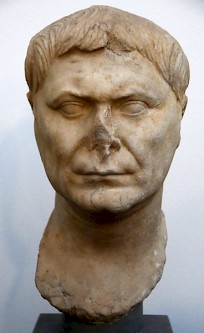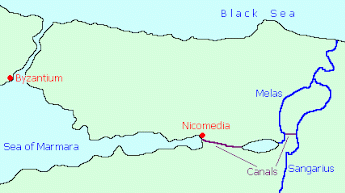Pliny the Younger (10)
Pliny the Younger or Gaius Plinius Caecilius Secundus (62-c.115): Roman senator, nephew of Pliny the Elder, governor of Bithynia-Pontus (109-111), author of a famous collection of letters.

As we have seen above, Pliny cultivated an image of both power and kindness, which enabled him to give orders to the members of the local elite and yet keep their cooperation. In this section of this article, we will discuss the results of Pliny's activities in the crisis province Bithynia-Pontus.
To start with, the new governor put all towns under legal constraint. If they wanted to spend large sums of money, they had to ask permission. This may seem a simple measure, but it must have been resented deeply by the members of the local elite, who were morally obliged to play a role in large-scale building projects. And although the wealthy Bithynians could not deny that they had almost ruined the province, it was a splendid achievement that the legatus Augusti pro praetore consulari potestate ex senatusconsulto missus was able to put all towns under legal constraint.
From now on, every large expenditure had to be reported to Pliny, who simply said "no" or "yes"; if he accepted the request, he would forward it to the emperor, who made the final decision. The following letter is representative, and reminds one of the fact that Pliny had once been responsible for the sewers of Rome.
Among the chief features of Amastris (a city which is well built and laid out) is a long street of great beauty. Throughout the length of this, however, there runs what is called a stream, but is in fact a filthy sewer, a disgusting eyesore which gives off a noxious stench. The health and appearance alike of the city will benefit if it is covered in, and with your permission this shall be done. I will see that money is not lacking for a large-scale work of such importance.note
Pliny not only inspected the expenditures, but also the incomes of the towns. In several letters, he refers to the recovery of overdue debts. Most of his measures were meant to reorganize public finances. Only rarely he tried to change things structurally.

An example of these rare measures can be found in Letter 10.41. On one of his travels, Pliny had seen that behind Nicomedia (modern Izmit), there was a large lake (Sapanca Göl), which was connected through the rivers Melas and Sangarius with the Black Sea and Central Anatolia. The governor now proposed the construction of two canals: one to connect the lake with Nicomedia, the other to make a shortcut between the two rivers. It would be easier to irrigate the country, and the canal would connect Nicomedia (which was situated at the end of the narrow gulf that extends due east from the Sea of Marmara) with both Central Anatolia and the Black Sea.
It was one of the best ideas of the former curator of the bed and banks of the Tiber and sewers of Rome. Only a small difference in height had to be bridged, and it would be easy to force the populace to do its duty to their community. (The Roman municipal law provided that every male citizen could be required to work for five days on construction work.) The canal was still functioning in the nineteenth century.
But this was exceptional. Usually, Pliny was content just to inspect the accounts and reorganize public finances. He once acted as a fideicommissary. This meant that he temporarily took possession of an estate that was left to the municipality of Tium and Heraclea, which could not otherwise inherit.note He investigated the expenses of a small town that was unable to pay for the traffic police on the highway from Bithynia to Central Anatolia.note These examples are more representative than the canal.
Pliny was also interested in unsuccessful building projects. He wrote a letter to the emperor to request for an engineer to investigate the building of an aqueduct; an architect advised him on the foundation of a theater in Nicaea; he checked the finances of the baths of Claudiopolis. Usually, it was a matter of efficient accounting. It does not sound spectacular, but the interim manager of Bithynia-Pontus was ultimately successful. After a year, he had to inform the emperor that a surplus had been created.note
The crisis in the Bithynian finances had been averted, and after a year and a half, Pliny returned to Italy. He had been a successful governor: the finances had been reorganized and the local elite had learned its lesson. The correspondence he had exchanged with Trajan was published as a tenth book of his Letters. This must have happened before 117, the year in which the emperor died.
Pliny did not occupy other offices. He was more than fifty years old. We do not known anything about his old age, except for the fact that he made his will. He left a large amount of money to his native town Como, to build baths. 300,000 sesterces were used to decorate them, and 200,000 sesterces were set apart - the interest served for the upkeep of the baths. He also released a hundred of his slaves and established a fund to support them after his death.
This was an ordinary will of an ordinary senator. To the modern historian, Pliny is a very important person. Not because he did something special, but on the contrary, because he is typical of the senatorial class of the high empire.
Literature
- Jona Lendering, Een interim-manager in het Romeinse Rijk. Plinius in Bithynië, 1998 The Hague
- Pliny the Younger, Letters and Panegyricus, with an English translation by Betty Radice, 1969 Cambridge Mass.
- A.N. Sherwin-White, The Letters of Pliny. A Historical and Social Commentary, 1966 Oxford
- Wynne Williams, Pliny the Younger. Correspondence with Trajan from Bithynia, 1990 Warminster